Restaurant
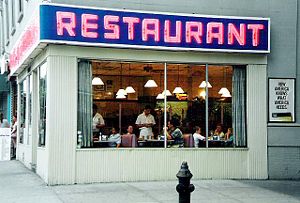
A restaurant prepares and serves food and drink to customers. Meals are generally served and eaten on premises, but many restaurants also offer take-out and food delivery services. Restaurants vary greatly in appearance and offerings, including a wide variety of cuisines and service models. Restaurants may include waitstaff, others provide counter service, and some are buffet style.
A restaurant owner is called a restaurateur; both words derive from the French verb restaurer, meaning "to restore". Professional artisans of cooking are called chefs, while prep staff and line cooks prepare food items in a more systematic and less artistic fashion.
Contents |
History
China
- Further information: Culture of the Song Dynasty#Food and cuisine

Food catering establishments which may be described as restaurants were known since the 11th century in Kaifeng, China's northern capital during the first half of the Song Dynasty (960–1279). With a population of over 1 million people, a culture of hospitality and a paper currency, Kaifeng was ripe for the development of restaurants. Probably growing out of the tea houses and taverns that catered to travellers, Kaifeng's restaurants blossomed into an industry catering to locals as well as people from other regions of China.[1] Stephen H. West argues that there was a direct correlation between the growth of restaurant businesses and institutions of theatrical stage drama, gambling, and prostitution which served the burgeoning merchant middle class during the Song.[2]
Restaurants catered to different styles of cuisine, price brackets, and religious requirements. Even within a single restaurant much choice was available, and people ordered the entree they wanted from written menus.[1] An account from 1275 writes of Hangzhou, the capital city for the last half of the dynasty:
- "The people of Hangzhou are very difficult to please. Hundreds of orders are given on all sides: this person wants something hot, another something cold, a third something tepid, a fourth something chilled; one wants cooked food, another raw, another chooses roast, another grill".[3]
The restaurants in Hangzhou also catered to many northern Chinese who had fled south from Kaifeng during the Jurchen invasion of the 1120s, while it is also known that many restaurants were run by families formerly from Kaifeng.[4]
Ma Yu Ching's Bucket Chicken House was established in Kaifeng in 1153 AD during the Jurchen-controlled Jin Dynasty (though documentation does not exist to prove continuous service) and is still serving meals today.
Islamic world
Restaurants came into existence throughout the medieval Islamic world from roughly around the same time as China. The Islamic world had "restaurants where one could purchase all sorts of prepared dishes." These restaurants were mentioned by Al-Muqaddasi (born 945) in the late 10th century.[5]
Restaurants in medieval Islamic Spain served three-course meals, which was earlier introduced in the 9th century by Ziryab, who insisted that meals should be served in three separate courses consisting of soup, the main course, and dessert.[6]
Western world
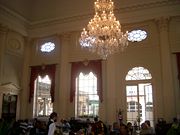
In the West, while inns and taverns were known from antiquity, these were establishments aimed at travellers, and in general locals would rarely eat there. Restaurants, as businesses dedicated to the serving of food, and where specific dishes are ordered by the guest and generally prepared according to this order, emerged only in the 18th century. According to the Guinness Book of Records, the Sobrino de Botin in Madrid, Spain, is the oldest restaurant in existence today. It opened in 1725. Another claim to be the world's oldest restaurant is made by Stiftskeller St. Peter in Salzburg, which has been in existence since 803 AD, since the time of emperor Charlemagne.
The term restaurant (from the French restaurer, to restore) first appeared in the 16th century, meaning "a food which restores", and referred specifically to a rich, highly flavoured soup. It was first applied to an eating establishment in around 1765 founded by a Parisian soup-seller named Boulanger. The first restaurant in the form that became standard (customers sitting down with individual portions at individual tables, selecting food from menus, during fixed opening hours) was the Grand Taverne de Londres (the "Great Tavern of London"), founded in Paris in 1782 by a man named Antoine Beauvilliers, a leading culinary writer and gastronomic authority[7] who achieved a reputation as a successful restaurateur. He later wrote what became a standard cookbook, L'Art du cuisinier (1814).
Restaurants became commonplace in France after the French Revolution broke up catering guilds and forced the aristocracy to flee, leaving a retinue of servants with the skills to cook excellent food; whilst at the same time numerous provincials arrived in Paris with no family to cook for them. Restaurants were the means by which these two could be brought together — and the French tradition of dining out was born.
A leading restaurant of the Napoleonic era was the Véry, which was lavishly decorated and boasted a menu with extensive choices of soups, fish and meat dishes, and scores of side dishes. Balzac often dined there.[8] Although absorbed by a neighboring business in 1869, the resulting establishment Le Grand Véfour is still in business.
The restaurant described by Britannica as the most illustrious of all those in Paris in the 19th century was the Café Anglais (the "English coffee-shop") on the Boulevard des Italiens, showing for a second time the high regard that Parisians evidently had for London, England, and the English — at least when it came to naming their restaurants.
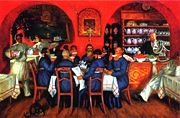
Restaurants then spread rapidly across the world, with the first in the United States (Jullien's Restarator) opening in Boston in 1794. Most however continued on the standard approach of providing a shared meal on the table to which customers would then help themselves (Service à la française, commonly called "family style" restaurants), something which encouraged them to eat rather quickly. Another formal style of dining, where waiters carry platters of food around the table and diners serve themselves, is known as Service à la russe, as it is said to have been introduced to France by the Russian Prince Kurakin in the 1810s, from where it spread rapidly to England and beyond. The familiar pattern of service where customers are given a plate with the food already arranged on it is called "American Service," though it surely did not originate in America.
Types of restaurants
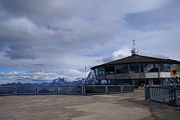
Restaurants range from unpretentious lunching or dining places catering to people working nearby, with simple food served in simple settings at low prices, to expensive establishments serving refined food and wines in a formal setting. In the former case, customers usually wear casual clothing. In the latter case, depending on culture and local traditions, customers might wear semi-casual, semi-formal, or even in rare cases formal wear.
Typically, customers sit at tables, their orders are taken by a waiter, who brings the food when it is ready, and the customers pay the bill before leaving. In finer restaurants there will be a host or hostess or even a maître d'hôtel to welcome customers and to seat them. Other staff waiting on customers include busboys and sommeliers.
Restaurants often specialize in certain types of food or present a certain unifying, and often entertaining, theme. For example, there are seafood restaurants, vegetarian restaurants or ethnic restaurants. Generally speaking, restaurants selling "local" food are simply called restaurants, while restaurants selling food of foreign origin are called accordingly, for example, a Chinese restaurant and a French restaurant.
Restaurant regulations
- See also: food safety
Depending on local customs and the establishment, restaurants may or may not serve alcohol. Restaurants are often prohibited from selling alcohol without a meal by alcohol sale laws; such sale is considered to be activity for bars, which are meant to have more severe restrictions. Some restaurants are licensed to serve alcohol ("fully licensed"), and/or permit customers to "bring your own" alcohol (BYO / BYOB). In some places restaurant licenses may restrict service to beer, or wine and beer.
Restaurant guides
Restaurant guides review restaurants, often ranking them or providing information for consumer decisions (type of food, handicap accessibility, facilities, etc). In 12th century Hanzhou (mentioned above as the location of the first restaurant,) signs could often be found posted in the city square listing the restaurants in the area and local customer's opinions of the quality of their food. This was an occasion for bribery and even violence. Today, restaurant review is carried out in a more civilized manner. One of the most famous contemporary guides, in Western Europe, is the Michelin series of guides which accord from 1 to 3 stars to restaurants they perceive to be of high culinary merit. Restaurants with stars in the Michelin guide are formal, expensive establishments; in general the more stars awarded, the higher the prices. The main competitor to the Michelin guide in Europe is the guidebook series published by Gault Millau. Unlike the Michelin guide which takes the restaurant décor and service into consideration with its rating, Gault Millau only judges the quality of the food. Its ratings are on a scale of 1 to 20, with 20 being the highest.
In the United States, the Mobil Travel Guides and the AAA rate restaurants on a similar 1 to 5 star (Mobil) or diamond (AAA) scale. Three, four, and five star/diamond ratings are roughly equivalent to the Michelin one, two, and three star ratings while one and two star ratings typically indicate more casual places to eat. In 2005, Michelin released a New York City guide, its first for the United States. The popular Zagat Survey compiles individuals' comments about restaurants but does not pass an "official" critical assessment. In the United States Gault Millau is published as the Gayot guide, after founder Andre Gayot. Its restaurant ratings use the same 20 point system, and are all published online.
The Good Food Guide, published by the Fairfax Newspaper Group in Australia, is the Australian guide listing the best places to eat. Chefs Hats are awarded for outstanding restaurants and range from one hat through three hats. The Good Food Guide also incorporates guides to bars, cafes and providers. The Good Restaurant Guide is another Australian restaurant guide that has reviews on the restaurants as experienced by the public and provides information on locations and contact details. Any member of the public can submit a review.
Nearly all major American newspapers employ restaurant critics and publish online dining guides for the cities they serve. A few papers maintain a reputation for thorough and thoughtful review of restaurants to the standard of the good published guides, but others provide more of a listings service.
More recently Internet sites have started up that publish both food critic reviews and popular reviews by the general public. This is a growing area and the market is still immature with no sites yet gaining dominant public or critical support. Several are gaining traction including Zagat.com, chowhound.com, and Fodors.com. Their major competition comes from bloggers and search engines since search engines often favor active bloggers over large somewhat static websites.
One interesting twist is Menuism.com, where they review the dishes rather than the restaurant. Many of these sites also offer discount coupons and maps.
Many diners use restaurant guides to make decisions as to where to eat. User generated sites such as Yelp.com and Citysearch.com provide user reviews that are valuable when making this decision. Another valuable guide to use when deciding where to eat is Allmenus.com. Allmenus.com provides restaurant menus for most restaurants in the US.
Economics
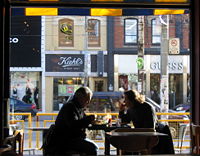
As of 2006, there are approximately 215,000 full-service restaurants in the United States, accounting for $298 billion, and approximately 250,000 limited-service (fast food) restaurants, accounting for $260 billion.[9]
There are 86,915 commercial foodservice units in Canada, or 26.4 units per 10,000 Canadians. By segment, there are: [10]
- 38,797 full-service restaurants
- 34,629 limited-service restaurants
- 741 contract and social caterers
- 6,749 drinking places
Fully 63% of restaurants in Canada are independent brands. Chain restaurants account for the remaining 37%, and many of these are locally owned and operated franchises. [11]
One study of new Cleveland, Ohio restaurants found that 1 in 4 changed ownership or went out of business after one year, and 6 out of 10 did so after three years. (Not all changes in ownership are indicative of financial failure.)[12] The three-year failure rate for franchises was nearly the same.[13]
See also
- Foodservice
- National Restaurant Association
- Food Street
- Culinary arts
- Food safety
- Food quality
References
Notes
- ↑ 1.0 1.1 Gernet, 133.
- ↑ West, 69–76.
- ↑ Kiefer, 5–7.
- ↑ Gernet, 133–134.
- ↑ Lindsay, James E. (2005), Daily Life in the Medieval Islamic World, Greenwood Publishing Group, p. 131, ISBN 0313322708
- ↑ Salma Khadra Jayyusi and Manuela Marin (1994), The Legacy of Muslim Spain, p. 117, Brill Publishers, ISBN 9004095993
- ↑ Encyclopaedia Britannica 15th Ed.
- ↑ Britannica Online Encyclopedia: Restaurant
- ↑ 2006 U.S. Industry & Market Outlook by Barnes Reports.
- ↑ CRFA’s Provincial InfoStats and Statistics Canada
- ↑ ReCount/NPD Group and CRFA’s Foodservice Facts
- ↑ The Restaurant Failure Myth by Kerry Miller. Business Week. April 16, 2007. Cites an article by H.G. Parsa in Cornell Hotel & Restaurant Administration Quarterly, published August, 2005.
- ↑ Ibid, page 2
Bibliography
- Gernet, Jacques (translated by H. M. Wright) (1962), Daily Life in China on the Eve of the Mongol Invasion, 1250-1276, Stanford: Stanford University Press, ISBN 0-8047-0720-0
- Kiefer, Nicholas M. (August 2002). "Economics and the Origin of the Restaurant". Cornell Hotel and Restaurant Administration Quarterly,: pp 5–7. http://www.arts.cornell.edu/econ/kiefer/Restaurant.PDF.
- Lundberg, Donald E., The Hotel and Restaurant Business, Boston : Cahners Books, 1974. ISBN 0843620447
- Spang, Rebecca L. (2000), The Invention of the Restaurant, Harvard University Press
- West, Stephen H. "Playing With Food: Performance, Food, and The Aesthetics of Artificiality in The Sung and Yuan," Harvard Journal of Asiatic Studies (Volume 57, Number 1, 1997): 67–106.
- Whitaker, Jan (2002), Tea at the Blue Lantern Inn: A Social History of the Tea Room Craze in America", St. Martin's Press.
External links
- The National Restaurant Association for the USA
- The Montreal Restaurant Guide to Eat Well Vous Mangez Ici Montreal